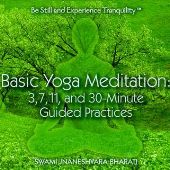|
|
See also: Following is not meant to be absolutely authoritative; it is excerpted from Wikipedia on Adi Shankaracharya: Adi Shankara (788 CE - 820 CE) was an Indian
philosopher who consolidated the doctrine of Advaita Vedanta, the most
influential sub-school of Vedanta. His teachings are based on the unity
of the soul and Brahman, in which Brahman is viewed as without
attributes. Shankara was born to Kaippilly Sivaguru Nambudiri and
Aryambya Antharjanam in the region of Kalady, in central Kerala.
According to lore, it was after his parents, who had been childless for
many years, prayed at the Vadakkunnathan temple, that Sankara was born
under the star Thiruvathirai. From a young age, Shankara was inclined towards sannyasa, but it was only after much persuasion that his mother finally gave her consent. Shankara then left Kerala and travelled towards North India in search of a guru. On the banks of the Narmada River, he met Govinda Bhagavatpada, the disciple of Gaudapada. When Govinda Bhagavatpada asked Shankara's identity, he replied with an extempore verse that brought out the Advaita Vedanta philosophy. Govinda Bhagavatapada was impressed and took Shankara as his disciple. The guru instructed Shankara to write a commentary on the Brahma Sutras and propagate the Advaita philosophy. One of the most famous debates of Adi Shankara was with the ritualist Mandana Mishra. Mandana Mishra's guru was the famous Mimamsa philosopher, Kumarīla Bhatta. Shankara sought a debate with Kumarīla Bhatta and met him in Prayag where he had buried himself in a slow burning pyre to repent for sins committed against his guru: Kumarīla Bhatta had learned Buddhist philosophy from his Buddhist guru under false pretenses, in order to be able to refute it. Learning anything without the knowledge of one's guru while still under his authority constitutes a sin according to the Vedas. Kumarīla Bhatta thus asked Adi Shankara to proceed to Mahismati (known today as Mahishi Bangaon, Saharsa in Bihar) to meet Mandana Mishra and debate with him instead. After debating for over fifteen days, with Mandana Mishra's wife acting as referee, Mandana Mishra accepted defeat. Ubhaya Bhāratī then challenged Adi Shankara to have a debate with her in order to 'complete' the victory. Later, Ubhaya Bhāratī conceded defeat in the debate and allowed Mandana Mishra to accept sannyasa with the monastic name Sureśvarācārya, as per the agreed rules of the debate. Adi Shankara founded four Mathas to guide the Hindu religion. These are at Sringeri in Karnataka in the south, Dwaraka in Gujarat in the west, Puri in Orissa in the east, and Jyotirmath (Joshimath) in Uttarakhand in the north. Hindu tradition states that he put in charge of these mathas his four main disciples: Sureshwaracharya, Hastamalakacharya, Padmapadacharya, and Totakacharya respectively. The heads of the mathas trace their authority back to these figures. Each of the heads of these four mathas takes the title of Shankaracharya ("the learned Shankara") after the first Shankaracharya. Advaita ("non-dualism") is often called a monistic system of thought. The word "Advaita" essentially refers to the identity of the Self (Atman) and the Whole (Brahman). The key source texts for all schools of Vedānta are the Prasthanatrayi– the canonical texts consisting of the Upanishads, the Bhagavad Gita and the Brahma Sutras.
-------
|
|
